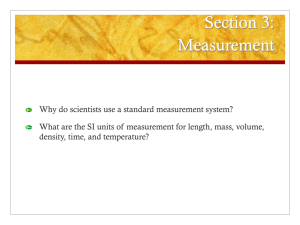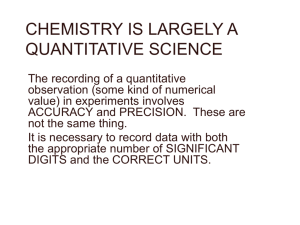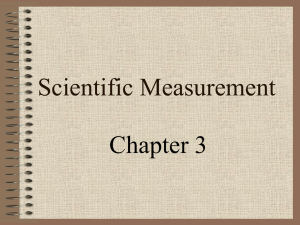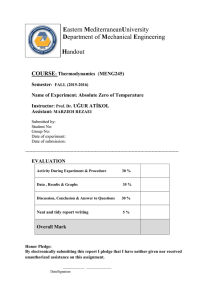Introduction to Organic and Biochemistry (CHE 124) Reading Assignment
advertisement
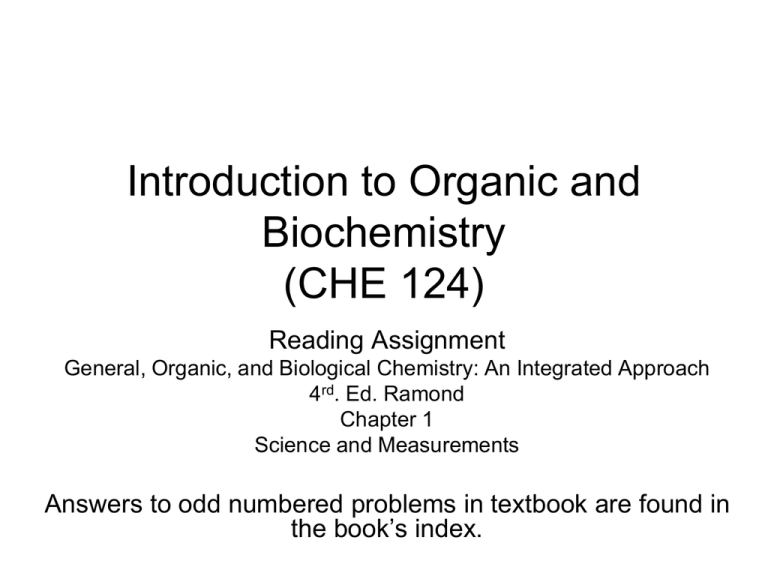
Introduction to Organic and Biochemistry (CHE 124) Reading Assignment General, Organic, and Biological Chemistry: An Integrated Approach 4rd. Ed. Ramond Chapter 1 Science and Measurements Answers to odd numbered problems in textbook are found in the book’s index. What is Chemistry? • Chemistry - the study of matter and the changes that it undergoes (e.g. reactions). Chemistry is the central science. It unifies the sciences in biology, physics, engineering, medicine, pharmacy, etc. What is the scientific Method? The scientific method is a way of gathering and interpreting information about chemistry (see next slide). – Hypothesis • tentative explanation (educated guess) for observations and known facts. – Theory • an experimentally tested explanation of an observed behavior. (a well tested hypothesis) – Law • statement that describe things that are consistently and reproducibly observed. (a well tested theory) Scientific Method Creativity Observation Form (New) Hypothesis Experiments Revise Hypothesis Discard Hypothesis Accept Hypothesis Theory • Matter What is Matter? – anything that has mass and occupies space. • Weight – measure of gravitational pull against matter. • Mass – measure of amount of material. • Phases of Matter – Solids • Fixed volume and shape – Liquids • Fixed volume, indefinite shape. • A liquids takes on the shape of the container. – Gases • Indefinite shape and volume. • A gas takes on both the shape and volume of the container. Properties of Substances • Every pure substance has its own unique set of properties that serve to distinguish it from all other substances. – Look them up in the chemical literature – These properties are classified as: • Intensive properties – independent of amount of substance. ( E.g. m.p., b.p., density) • Extensive properties – dependent on amount of substance. (e.g. mass, volume) • Chemical properties observed when the substance takes part in a chemical reaction • becomes a new substance – E.g. Heating Mercury (II) oxide to produce oxygen. – Does the substance react with oxygen? • Physical properties • No chemical change is required • Examples: – Melting point (m.p.) – temp. when substance changes from solid to liquid. – Boiling point (b.p.) – temp. when substance changes from liquid to gas. m – Density = d v – Solubility = amount of solute that dissolves in a give amount (100g) of solvent at a specific temp. – Color What is Energy? • Energy • The ability to do work and / or to transfer heat. – Potential energy • stored energy – Kinetic energy • energy of motion Measurements • Chemistry is a quantitative science. We use the SI system of measures. • SI Units International System of Measure – Common name: the metric system – Based on the decimal (powers of ten) – Kg, L, K, °C • English system is used in the United States. Measuring Length • SI unit of Length = meter (m) – Definition of meter - the distance light travels in 1/299,792,458 of one second • 1 m = 39.37 in. • English units – mile (m), yard (yd.), foot (ft.),inch (in.) • Instruments used to measure length – Meter stick – Micrometer Measuring Volume • SI Unit of Volume = Liter (L) – Volume is derived from SI unit of length. – Units of volume • cubic meter (m3) = 1000 L • cubic centimeter (cm3 or cc)= milliliters (mL) • English Units – Gallon (gal.), quart (qt.), pint (pt.), cup (c), teaspoon (tsp.) , table spoon (tbsp.), fluid ounce (oz.) • Instruments used to measure volume – Graduated cylinder, pipet or buret, digital micropipet Measuring Mass • SI Unit = kilogram (kg) – Definition of kg • The kilogram is the unit of mass; it is equal to the mass of the international prototype of the kilogram. • Kilogram (kg) = 1000 g • 1 gram (g) = 1000 mg • English Units – Ton (ton.), pound (lb.), ounce (oz.) • Instruments used to measure mass – Balance – Scale Mass vs Weight • Mass – Amount of matter in a sample. • Weight – The effect of gravity on the matter. SI Units Base Quantity Name Symbol * Length * Mass * Time Electric current * Temperature * Amount of substance Luminous intensity Meter Kilogram Second Ampere Kelvin Mole Candela m kg s A K mol cd Source: http://physics.nist.gov/cuu/Units/units.html Derived SI Units Derived Quantity * Area * Volume * Speed, velocity Acceleration Name Symbol square meter cubic meter meter per second meter per second squared m2 m3 m/s m/s2 Derived SI Units with Special Names Derived quantity force * pressure, stress * energy, work, quantity of heat power, radiant flux * Celsius temperature Name Expression Expression Symbol in terms of in terms of other SI units SI base units newton N - m·kg·s-2 pascal Pa N/m2 m-1·kg·s-2 joule J N·m m2·kg·s-2 watt W J/s m2·kg·s-3 degree Celsius °C - K Metric Prefixes Prefix mega kilo hecto deca Unit deci centi milli micro nano Symbol Multiple 1,000,000 M 1,000 k 100 h 10 da 1 ------0.1 d 0.01 c 0.001 m 0.000001 μ 0.000000001 n 1 x 106 1 x 103 1 x 102 1 x 10 1 1 x 10-1 1 x 10-2 1 x 10-3 1 x 10-6 1 x 10-9 English Conversions Length Volume 1 mile (m) = 5280 feet (ft.) 1 gallon (gal) = 4 quarts (qt.) 1 ft. = 12 inches (in.) 1 qt. = 2 pints (pt.) 1 yard (yd.) = 3 ft. Mass 1 pt. = 2 cups (c.) 1 pt. = 16 fluid ounces (fl. oz.) 1 c. = 8 fl. oz. 1 ton = 2000 pounds (lbs.) 1 in3 = 16.387 cm3 1 lb. = 16 ounces (oz.) 2 tablespoons (T or tbsp) = 1 fl. oz English to Metric Conversions Length 1 in. = 2.54 cm (exact) 1 m = 39.37 in 1 mi = 1.609 km Volume 1 ft3 = 28.32 L 1 L = 1.057 qt 1 gal. = 3.785 L 1 tsp. = 5 mL 1 tbsp = 15 mL 1 mL = 15 drops (gtt) Mass 1 lb. = 453.6 g = 0.4536 kg 1 g = 0.03527 oz. 1 kg = 2.2 lbs. Typical Conversions Problems • The dosage on a bottle of medicine reads: “Take 2 tablespoons every twelve hours.” Convert this volume to mL. • The box at the pet store states: “Aquarium volume is 55 gal.”. Convert this volume to liters. • The distance (length) from Clinton to Vicksburg is appr. 32 miles. What is this distance in cm? • A marathon is defined as 42.195 km. What is this distance in miles? Measuring Temperature • Factor that determines the direction of heat flow • SI units = °C or K – Fahrenheit (°F) • Named after German instrument maker Daniel Fahrenheit (1686 -1736) – Celsius (°C) (old name centigrade) • Named after Swedish astronomer Anders Celsius (1701-1744) – Kelvin (K) • Do not use (°) or degree in relation to K. • Defined as 1/273.16 of the difference between the lowest attainable temp. (0K) and the triple point of water (0.01 °C) • Instruments to measure – Mercury thermometer • Mercury expands and contracts as temperature changes. Tube contains only 2% of the Hg in thermometer. – Digital thermometer • • Water boils = 212 °F = 100 °C = 373.15 K Water freezes = 32 °F = 0 °C = 273.15 K – Triple point is the temp. /pressure combination at which water is capable of coexisting as a solid, liquid and gas. Converting Temperature Scales • Comparing °F to °C – 0 °C is 32 °F • Freezing point of water F 1.8C 32 – 100 °C is 212 °F • Boiling point of water – There are 180 Fahrenheit degrees for every 100 Celsius degrees, so each °C is 1.8 times larger than each °F • Comparing °C to K – Celsius degree and Kelvin degree are the same size. K C 273.15 Scientific Notation • A way of dealing with very large or very small numbers. • Show examples on the board: – Avogadro number 6.022 X 1023 – 83,000 – 0.000056 – See table 1.3 p.12 Accuracy vs Precision • Accuracy – How close a reported value is to the real value. (see next slide about error). • Precision – A measure of how close repeated measurements are to one another. Uncertainties in Measurements • How much solution is in the large graduated cylinder? • How much solution is in the small graduated cylinder? • Do these two measurements have the same uncertainty? Uncertainties in Measurements • Three volume measurements with their uncertainties – Large graduated cylinder, 8 ± 1 mL – Small graduate cylinder, 8.0 ± 0.1 mL – Pipet or buret, 8.00 ± 0.01 mL • To denote how much uncertainty is in a measurement, Significant figures are used. • Significant Figures – Every measurement carries uncertainty – All measurements must include estimates of uncertainty with them – There is an uncertainty of at least one unit in the last digit • Text convention – Uncertainty of ± in the last digit is assumed but not stated Significant Figures • Significant figures are meaningful digits in measurements – In 8.00 mL, there are three significant figures – In 8.0 mL, there are two significant figures – In 8 mL, there is one significant figure Ambiguity in Significant Figures • Consider the measurement, 500 g – If the measurement was made to the nearest 1 g, all three digits are significant – If the measurement was made to the nearest 10 g, only two digits are significant – Resolve by using scientific notation • 5.00 X 102 g • 5.0 X 102 g • See Table 1.5 p. 17 Rounding • Rounding off numbers – If the first digit to be discarded is 5 or greater, round up – If the first digit to be discarded is 4 or smaller, round down Significant Figures in Calculations • Addition and Subtraction – Count the number of decimal places in each number – Round off so that the answer has the same number of decimal places as the measurement with the greatest uncertainty (i.e., the fewer number of decimal places). • Multiplication and Division – When multiplying or dividing two numbers, the answer is rounded to the number of significant figures in the less (or least in the case of three or more) measurements – 2.40 X 2 = 5 • Exact Numbers – Exact numbers carry an infinite number of significant figures • Exact numbers do not change the number of significant figures in a calculation – Example: The numbers 1.8 and 32 in the conversion between Fahrenheit and Celsius Dimensional Analysis / Factor Label / Converting Units • In many cases throughout your study of chemistry, the units (dimensions) will guide you to the solution of a problem • A correct answer must have the NUMBER and UNITS! • Conversion factors are used to convert one set of units to another – Only the units change – Conversion factors are numerically equal to 1 • 1L = 1000 cm3 Choose a conversion factor that puts the initial units in the denominator – The initial units will cancel – The final units will appear in the numerator 1L 1000 cm3 1 3 3 1000 cm 1000 cm Some Examples • Convert 25 mL to L. • Convert 200 pounds to grams. • Convert 20 miles to kilometers. • Convert 25 microliters to liters. Properties of Substances • Every pure substance has its own unique set of properties that serve to distinguish it from all other substances. – Look them up in the chemical literature – These properties must be intensive. • Intensive properties – independent of amount of substance. ( E.g. m.p., b.p., density) • Extensive properties – dependent on amount of substance. (e.g. mass, volume) • Chemical properties observed when the substance takes part in a chemical reaction • becomes a new substance – E.g. Heating Mercury (II) oxide to produce oxygen. – Does the substance react with oxygen? • Physical properties • No chemical change is required • Examples: – Melting point (m.p.) – temp. when substance changes from solid to liquid. – Boiling point (b.p.) – temp. when substance changes from liquid to gas. – Density = m d v – Solubility = amount of solute that dissolves in a give amount (100g) of solvent at a specific temp. – Color Density • The density of a substance is its mass divided by its volume. (the amount of mass contained in a given volume.) • Units = g / mL • Density of: – Water is 1 g / mL • Temperature must be stated. – density changes with changes in temperature. • Note table 1.8 p. 22 m d v Specific Gravity • Relates density of a substance to that of water. – Measured using refractometeres, hydrometers or test strips. – Used to determine • • • • acid level in car batteries antifreeze level in car radiators alcohol content in beer and wine Urine to diagnose kidney problems – Temperature must be specified since the density of the substance and water vary, but not necessarily at the same rate. Specific Gravity = Density of substance = 0.785 g/mL = 0.785 Density of water 1.00 g/mL Specific Heat • Relates energy (in calories), mass (in grams), and temperature (in degrees Celsius). • Units = cal / g ∙ °C • Relates the mass, temperature, and energy.
